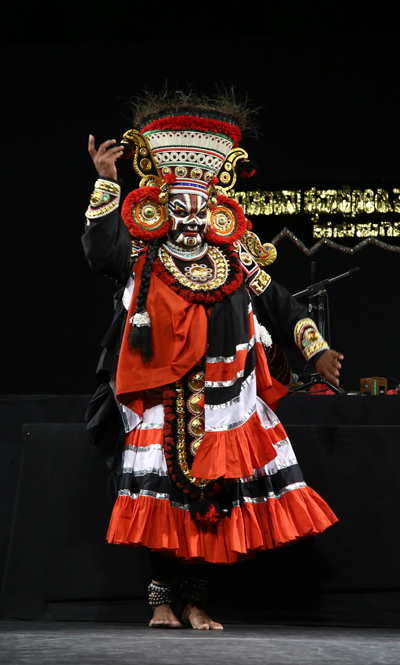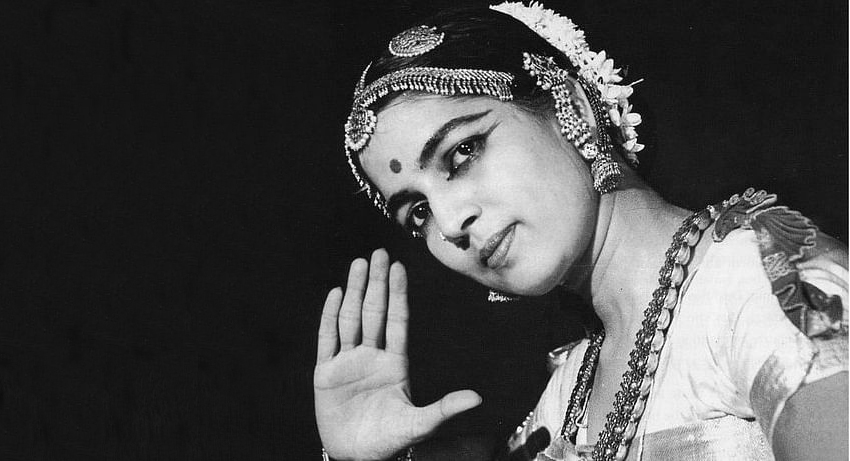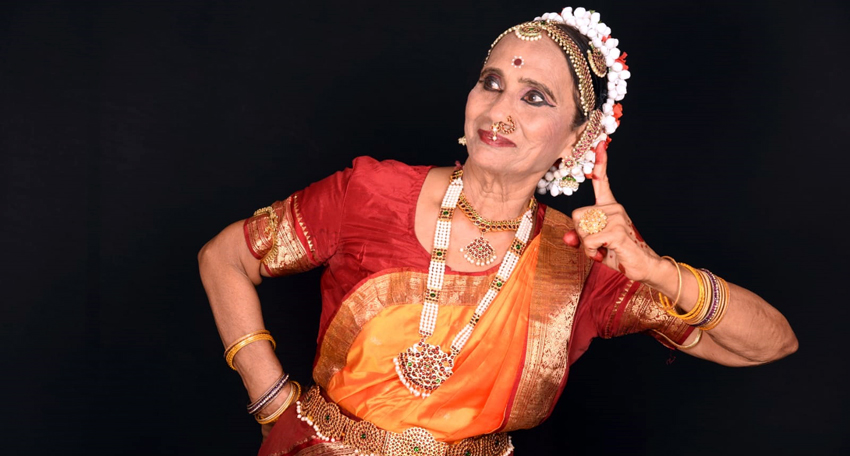The annual IIC Experience a festival the arts with its array of visual and performing arts including a film festival, a food festival and an exhibition ‘Se Chand Warq’ Awadh comprising a display of photographs, artifacts, archival textiles books and letters celebrating the cultural diversity of Lucknow, in its performing arts presentation, featured two dance forms Yakshagana and Odissi – as different as chalk from cheese- one a total peoples’ theatre form, comprising dance, music and drama from South Kanara District of Karnataka and the other a classical dance form of Odisha, which, while shaped by remnants from traditional art, assumed its present form only in the late nineteen fifties.
Yakshagana meaning the gana (music) of the celestials evolved post 15th century at about the same time or a bit later when regional theatre forms like the AnkiaNat in Assam, the Teru Kutu in Tamilnadu, Ottam Tulal in Kerala and many others in different regions of the country, came into being. Staged in the open air in fields during the night, the blend of music, dance, dialogue in these fantasy plays based on themes mostly from the epics, made these art forms very popular with the rural population in particular -though in today’s proscenium situation, with the large scale flow of rural population to urban areas, forms like Yakshagana are losing their space and audience, and gasping for breath, most of them finding survival very difficult.
Presented by Hanumagiri Meyla from Karnataka, the Yakshagana Prasanga (episode) Panchavati on the specially erected stage on the Fountain Lawns of the India International Centre, had a vibrant and electrifying start with Bhagavata’s (singer who conducts and virtually directs the entire performance) powerful, high pitched singing (in what is known as the early Gandhara Grama mode,) the drone or musical scale provided by the sruti petti, in place of the old sruti burude, which used to be a long gourd with bamboo pipe attached to the end which had to be blown to provide the steady note of the drone, which was quite strenuous for the person wielding it. The prayer to Ganapati in the raga Kalyani was followed by a brief rhythmic percussive interlude on the Chende (Chaitanya Krishna Padyana) and Chakratala cymbals) played by Prasad.
 The Prasanga for the evening was Panchavati – a fantasy world of Gods, Men and Demons created, based on a theme from the epics as customary. The demoniac characters were turned out in the most ornate costumes sporting mammoth headdresses and skirts (for males) and saree for females. Rama, Lakshmana clad in white dhoti with hair in a top knot and Sita too were all contrastingly simply attired. The venue of action was Panchavati in the Chitrakoot forest where Rama is seen trying to allay the misgivings of Sita who despite the calm and beauty of Nature all around, is unable to feel absolutely secure.
The Prasanga for the evening was Panchavati – a fantasy world of Gods, Men and Demons created, based on a theme from the epics as customary. The demoniac characters were turned out in the most ornate costumes sporting mammoth headdresses and skirts (for males) and saree for females. Rama, Lakshmana clad in white dhoti with hair in a top knot and Sita too were all contrastingly simply attired. The venue of action was Panchavati in the Chitrakoot forest where Rama is seen trying to allay the misgivings of Sita who despite the calm and beauty of Nature all around, is unable to feel absolutely secure.
In walks Surpanakha in her real form, gorgeously costumed, her visit to this part of the forest guided by the smell of human blood which has stirred her appetite. But when her eyes finally fall on the expected prey, lust takes over the appetite for human flesh, on seeing the two comely princes and she decides to transform herself into a desirable woman. Santosh Kumar as Maya Surpanakha trying to seduce Rama formed the highlight of the presentation and it was with his entry that the hitherto rather sedate narrative picked up, the curiosity of the audience roused.
The sheer variety of steps, beckoning gestures and glances used by the male actor as Surpanakha had to be seen to be believed! It was the art of seduction through abhinaya at its best! The music as Surpanakha went through the actions of ‘Solah sringar’ decorating herself with the melodious singing in raga Mohanam, introducing herself “Ati Kalaavati Naanu” by posturing as a great artist, and going into poetic gush remarking that just as the river embraces the Sea and becomes one with its waters, so too her overwhelming desire flowing like a river, is to get submerged in the ocean of Rama.
 The smooth tapestry woven of brief spoken-word exchanges with the larger expression through movement and gesture guided by and based on the musician’s singing, spoke of practised understanding- with no cues missed. And the sheer musical virtuosity with ragas like Charukesi, Kambodi, Brindavan Saranga apart from Mohanam and Kalyani – all sung with perfect voice control, spoke of classical Carnatic training. That the early Yakshagana performances were restricted to the musical form with dance perhaps included, later on, would explain how the dance in its squatting, jumping, reeling movements does not always pertain, except in odd patches, to a very stylized vocabulary. It was the great Yakshagana actor late Shivaram Karanth who through conscious effort brought in a great deal of sophistication into Yakshagana, widening the slender musical vocabulary of ragas too, working with veterans like Sheshagiri Kini and Januvarkatte Gopalkrishna Krishna Kamath who could sing for nine-hour presentations in the old days, at a stretch! That Ravichandra Kannadikatte’s sruti perfect music was arguably one of the highlights of the entire presentation. The individualistic, dance sequences were rendered with impeccable footwork and rhythmic exactitude.
The smooth tapestry woven of brief spoken-word exchanges with the larger expression through movement and gesture guided by and based on the musician’s singing, spoke of practised understanding- with no cues missed. And the sheer musical virtuosity with ragas like Charukesi, Kambodi, Brindavan Saranga apart from Mohanam and Kalyani – all sung with perfect voice control, spoke of classical Carnatic training. That the early Yakshagana performances were restricted to the musical form with dance perhaps included, later on, would explain how the dance in its squatting, jumping, reeling movements does not always pertain, except in odd patches, to a very stylized vocabulary. It was the great Yakshagana actor late Shivaram Karanth who through conscious effort brought in a great deal of sophistication into Yakshagana, widening the slender musical vocabulary of ragas too, working with veterans like Sheshagiri Kini and Januvarkatte Gopalkrishna Krishna Kamath who could sing for nine-hour presentations in the old days, at a stretch! That Ravichandra Kannadikatte’s sruti perfect music was arguably one of the highlights of the entire presentation. The individualistic, dance sequences were rendered with impeccable footwork and rhythmic exactitude.
[adrotate group=”9″]
The mutilated Surpanakha’s two brothers Kharasur (Subbaraya Holla and Dushan (Rakshit Shetty) who are both killed by Ram again were richly turned out and one was struck with the similarity in getup to the Kathakali Katti characters with enormous crowns and striking costume of contrasting black and red. All the demoniac characters moved mostly in pirouettes. Ram and Lakshman indulged in more verbal interaction than dancing and except for some gestures. Only in the case of Maya Surpanakha did one experience a wide range of movements. The pity was that much of the improvised dialogue, with hardly any Kannadigas in the audience, was lost on most of the people. Much of the humour and sarcasm, particularly when Rama responds to Surpanakha’s open invitation went overboard.
ODISSI MAGIC WITH MALE BODIES
The male dancers of Rudrakshya Foundation were a very pleasant surprise for most of the audience. Established by Guru Sri Bichitrananda Swain in 2000 in Bhubaneswar, the work of this institution has proved the truth of the idea of highly trained dancing bodies which are virtually genderless, which through movement expertise and deep involvement create the sense of masculinity or femininity through the dance. Meticulously trained by Bichitrananda Swain, these male dancers epitomize Odissi grace and allure at its best. Rarely does one get to experience the subtle movement deflections of the isolated torso in Odissi- as in these dancers – the way Guru Kelucharan Mohapatra introduced in his vision of what this dance form should be.
 Notably, Bichitrananda as a disciple of late Gangadhar Pradhan also trained under Guru Kelucharan at Odissi Research Centre. Kelucharan’s best disciples apart, torso movements today in most Odissi dancers has become less pronounced, particularly because of the greater speed in the dance which makes these micro-movements of deflection difficult to execute or invisible to the audience. But watching Rudrakshya boys, one sees how the sideways movement grace of the torso at its most supple dictates the tribhanga formation. Their performance whether in technique, in abhinaya, in group discipline where seven dancers are together, showed how it was the dancing body, without specific gender categorisations, which carried the day. In a suite of four excellent numbers all visualized with a fine creative imagination, “yah Krishna Saha Kali” showed the creative thinking of Bichitrananda, that he drew a contrast between two dark deities – Krishna with all his charm, grace and romantic attitude on one side and Kali familiar with the burning ground, and dark demons she has destroyed. And here was gender shown in slants which are understood and perceived differently.
Notably, Bichitrananda as a disciple of late Gangadhar Pradhan also trained under Guru Kelucharan at Odissi Research Centre. Kelucharan’s best disciples apart, torso movements today in most Odissi dancers has become less pronounced, particularly because of the greater speed in the dance which makes these micro-movements of deflection difficult to execute or invisible to the audience. But watching Rudrakshya boys, one sees how the sideways movement grace of the torso at its most supple dictates the tribhanga formation. Their performance whether in technique, in abhinaya, in group discipline where seven dancers are together, showed how it was the dancing body, without specific gender categorisations, which carried the day. In a suite of four excellent numbers all visualized with a fine creative imagination, “yah Krishna Saha Kali” showed the creative thinking of Bichitrananda, that he drew a contrast between two dark deities – Krishna with all his charm, grace and romantic attitude on one side and Kali familiar with the burning ground, and dark demons she has destroyed. And here was gender shown in slants which are understood and perceived differently.
Krishna the male had all the grace associated with the feminine, while Kali the female deity was shown in her destructive fearsome moods- common perception associated with male characters generally. And showing both attitudes were male dancers! And after the dancers in alternating segments bring out the difference in a striking change of attitudes comes the wisdom in the finishing line of the script prepared by a Bengali, that both represent different manifestations of the same cosmic entity. The differences exist only in the mind. And also a very astute observation that every attitude has to have its opposite – which indeed gives it its own identity. Light draws its qualities from its opposite – darkness. The extraordinarily disciplined dancing was a feature of the entire presentation. And whether aggression or benign grace, both attitudes could not have been better brought out. It was a dance at its best, and gender had to be looked for, in the danced attitudes.
[adrotate group=”9″]
In an absolutely riveting performance, two points need to paid attention to. One is the coloured lights which seemed overdone while the dancers were performing – with such excellent lines so much of extra lighting only smudges lines which are immaculate in themselves and need no ornamentation. The second point is the choreographer’s habit to needlessly spin out an item to a half-hour slot. Despite excellent rendition, stretching out an item for so long loses out on the optimum effect – for the viewer begins to feel that he is looking at the already seen.









